
This trip to the airfield was challenging, enlightening, embarrassing and involved an unexpected encounter with a YouTube star.
I walked into the clubhouse and met with the Chief Flight Instructor at the school who, like Jiminny Cricket to Pinnochio, would be doing his best to turn me into a real pilot. We quickly briefed that the weather was good and we’d do some flapless take offs and landings.
Flaps
Wings are designed so they perform best in the regime they are expected to be in most of the time – the long boring cruise parts. But when cruising, whether in a light aircraft or the heaviest of long haul airliners, you’re typically flying a lot faster than your take-off and landing speeds, and this requires wings to be ‘slippery’, to be aerodynamically efficient and not create much drag.
When in the cruise, wings also need to produce less lift because as speed increases the lift will also increase. Too much lift and the wings will bend too much, or worse.
To take off at cruise speeds, airliners would need runways miles and miles long, and to land at cruise speeds aircraft would touch down so fast as to risk damage. The solution was to allow the wing to change shape at different stages of flight using “high lift devices” such as flaps on the trailing edge of the wing and slats on the leading edge. These retractable devices increase the wing area and/or the curvature of the wing, increasing the lift it can produce at slower speeds.
The flaps on the Cessna 150 (C150) are simple hinged flaps known as “plain flaps” built into the trailing edge of the wing and are quite effective.

And today I’d be ignoring that flaps even exist – practising take offs and landings without the help of flaps.
But why?
The main reason we practice landing without flaps is that they can fail. For aircraft with electrically-operated flap systems, their electrics, motors or the electrical system of the aircraft can fail.
But what about take off? Surely you’d just reject the aircraft if the flaps didn’t work and go get a sandwich instead?
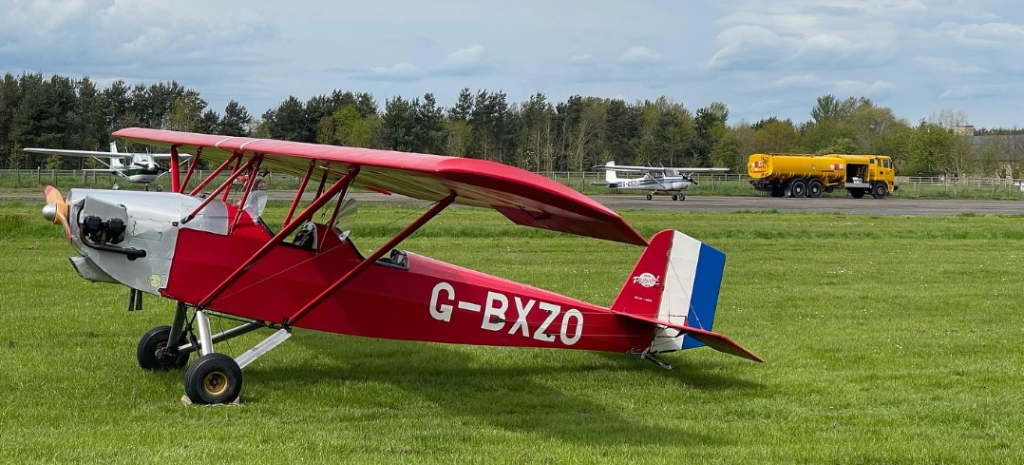
Zero Flap Take Off
After briefing with my instructor and running all the necessary checks on the aircraft we headed up to the holding point to run the power checks.
When we were happy that the aircraft was in good shape he said that without flaps it will feel “wallowy” after take off, and it won’t climb as well, but once you climb away from ground effect it will climb much better.
I made a radio call and lined up before pushing the throttle forward and adding a dab of right rudder – not at much as usual as a crosswind was developing from the right which helped counteract the left-yawing tendency.
At 60 knots, the same take-off speed as with flaps, with a bit of right aileron still applied to keep the wings level, I pulled back on the controls and the difference was immediately obvious. It took noticeably more back-pressure to life the nose and even more was required to keep the nose from dropping again.
So why would we do this? It takes around 10% more runway to do a flapless take off and longer to establish a climb once you’ve lifted off, what possible reason could make this a sane thing to do?
Eventually we got away from the ground and he wasn’t kidding, the little Cessna started to rocket away – I had to point the nose quite high to maintain a 60 knots Vy climb. And that’s the point – it allows for a much steeper climb after take-off than with your flaps hanging in the air stream. Good for those runways with cliff walls at the end!
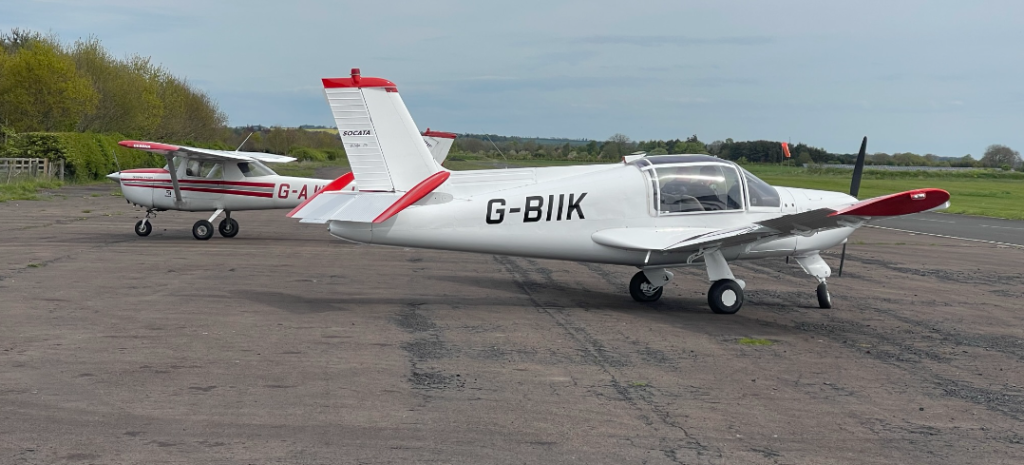
Zero Flap Landing
The Pooley’s Flying Training book says that zero flap landings are usually long and shallow with a higher speed and a lower power setting than a “flapped” landing, but my instructor recommended a different “approach” (pun fully intended!).
On base leg, I pulled the carb heat out, reduced power to 1500rpm and waited for the air speed to bleed away, which it stubbornly didn’t. Without the flaps to drain the energy away I had to hold the nose high in the air until it finally dropped to 60 knots (typical approach speed) and trimmed to maintain that as I descended and turned onto final.
We were now pretty high but maintained 60 all the way down and I performed a pretty good landing, even though I floated a bit down the runway – a trait of flapless landings because the flaps don’t suck the energy out of the aircraft during the flare.
Power in, carb heat away and I rocketed back up into the air and around the circuit again.
This time on base leg I got the nose up high earlier and trimmed for 60 knots much quicker. Turning onto final this time the instructor told me, “don’t fidget”, meaning stop changing things like power settings and attitude when I don’t need to! “In other words,” he said, “do less, let the plane do the work.”
Of course, he was right, and with minimal intervention the approach was better than my constant power and pitch oscillations. I reduced power at 50ft and pulled the nose up to arrest the descent, but then something happened that I’ve never had before on short-final: the stall warning horn squeaked.
I nearly shat a brick.
I pushed the nose forward and added a squirt of power, stabilised the flare and we touched down with a bump. “Full power!” said the instructor, and back up we went, this time requiring a lot of right aileron and a good kick of right rudder to counteract the increasing crosswind from the right.
So why did the stall warning horn go off? The whole point of the flaps is that they allow you to fly slower without stalling, i.e. they reduce your stall speed. So without flaps, the stall speed is higher (technically, the critical angle of attack is higher) and when I raised the nose I managed to approach the critical angle of attack and the pneumatically-powered stall warning horn triggered.
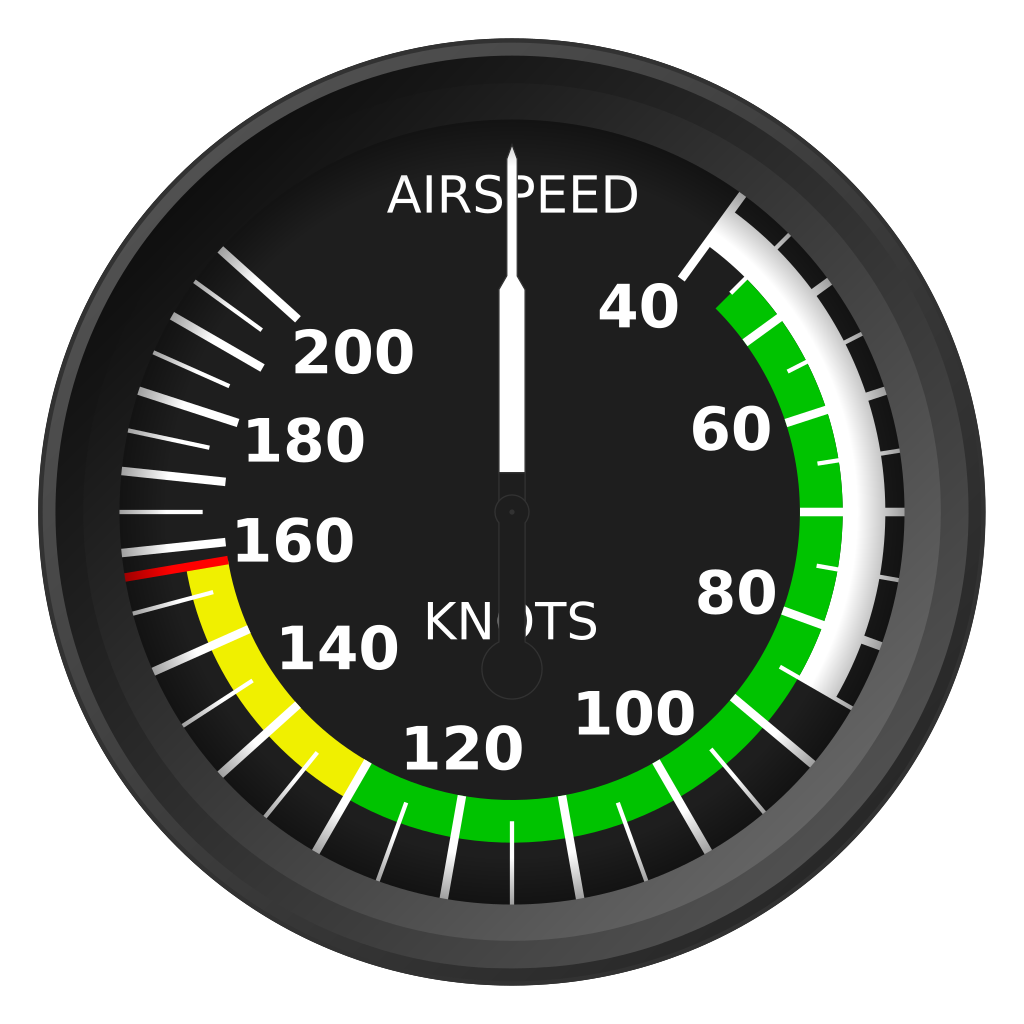
There are two stall speeds shown on the air speed indicator: Vs0 and Vs1.
Vs1 is shown on the ASI above as the start of the green arc at 45 knots. This is the stall speed of the aircraft in a clean configuration (i.e. no flaps).
Vs0 is shown as the start of the white arc at 40 knots. This is the stall speed of the aircraft with flaps extended. Someone once said they remember “Vs0” as “V-stuff-out” and that’s stuck in my head now.
So on this approach I must have gone down to Vs1 and entered the early stages of the stall, whereas normally with flaps I’d have another 5+ knots of air speed to play with.
That Crosswind and Traffic!
After a few more trips around the circuit my instructor was happy and I need to build up my solo hours so he jumped out and said I could try a mixture of flapless flapped landings for as long as I could afford.
As soon as he jumped out two aircraft radio’d that they were backtracking the runway in different directions. One aircraft left parking and backtracked runway 01 to Bravo (B), the other backtracked runway 19 to Charlie (C). So I was sat at parking waiting for them to do something. Anything.
Eventually I decided to just go for it, opting to use runway 19 as I had a feel for the wind and the approach. “Golf-Zulu-Uniform backtracking runway one-niner to charlie.”

There was a muffled call over the radio but I distinctly heard “Zulu-Uniform”, which was my abbreviated callsign.
“Say again for Zulu-Uniform?” I asked.
There was a sigh over the radio. “Golf-Zulu-Uniform overhead Alnwick, switching to Scottish Information.”
Wait, TWO Zulu-Uniforms on one station?! Amazing. A bit awkward asking them to repeat, but if in doubt…
I pulled into Charlie as the other aircraft was lining up on the runway and I got a great view of them on their take off roll as I ran through my power checks. The other aircraft at Bravo was still sat there with his propeller spinning so I took the opportunity and made a radio call, “Golf-Zulu-Uniform, lining up runway one-niner.”
I opted for another flapless take off for the practice and as soon as I lifted off and got above the tree line the crosswind hit the tail fin. The wings rocked left and the Cessna slid sideways. I caught it as quickly as I could, adding in buckets of rudder and aileron to avoid going over onto the grass runway (19G) which runs parallel to the hard runway 19. I let the wind weather-cock the tail a little to help me track straight on the extended runway centre line and was bumped all the way up to 1,000ft QFE (above airfield level – aal). The wind was picking up a lot and I had to crab 30 degrees on downwind just to avoid being blown towards the airfield.

For the next few circuits I was battered by the winds but then a new problem arose.
“Romeo Kilo descending deadside runway 25,” someone said over the radio.
There’s a convention that any aircraft already in the circuit dictate which runway is in use, and I was about to see why.
“Downwind runway 19,” I said at the appropriate moment to give them a hint that they were using a conflicting runway.
“Breaking off,” they said, turning north, I expected them to keep turning right and steer deadside for runway 19 but that didn’t happen.
A few seconds later, “Romeo Kilo, joining crosswind, runway 25.”
My brain did a double-take. Crosswind runway 25?!
Runway 25 has a left-hand circuit, which means you make left-hand turns. Crosswind is a leg that parallels runway 19/01 from north to south.
Runway 19 which I was using has a right-hand circuit and downwind which I was currently on is a leg that paralells runway 19/01 but from south to north – the other direction.
Oh, expletives.
Sure enough, I see them heading toward me and they end up passing me, at my height, slipping past between me and the airfield at a closing speed well in excess of 200mph, less than 300 yards away. “Got you in sight,” he said over the radio, I’m not sure if he was joking or not.
I did another flapless landing and went back around a few more times, each time there seemed to be another aircraft in the circuit.
Finally, I was coming down the approach, no flaps, nose crabbed 30 degrees to the right, airspeed indicator bouncing between 55 and 80 knots as gusts hit me, and I decided that was enough for today. I landed with a bump but firm enough to keep her planted on the deck, parked up and shut her down, taking a note of the all-important Hobbs.
The Flying Celebrity
There are a few aviation YouTube stars around and one of them is Jon Hunt, also known as The Flying Reporter. Jon is an ex-BBC reporter and now freelances, specialising in aviation-related videos.
And there, on the grass at the airfield, was Jon’s recognisable Piper.
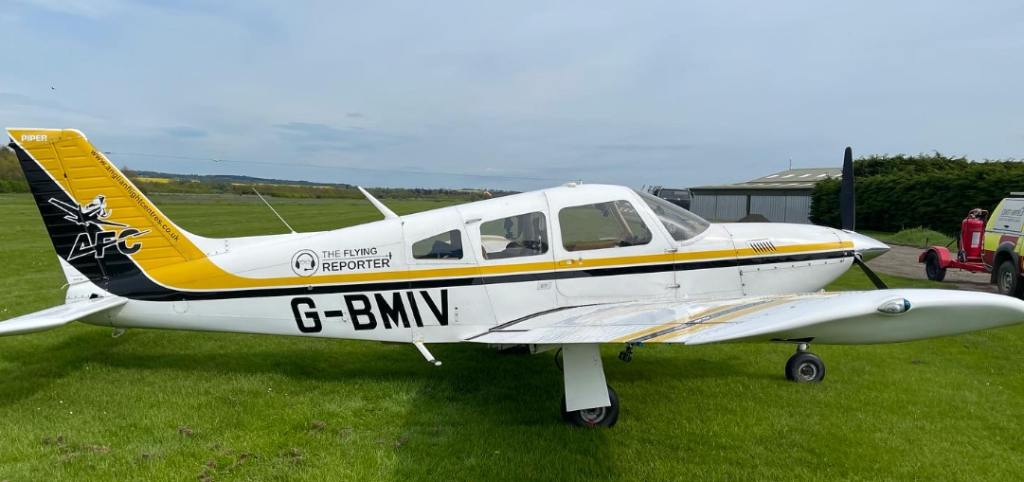
Sure enough, once I’d paid my money to the vengeful Gods of Hobbs, I spotted Jon walking around the picnic area with a large, very professional-looking camera over his shoulder.
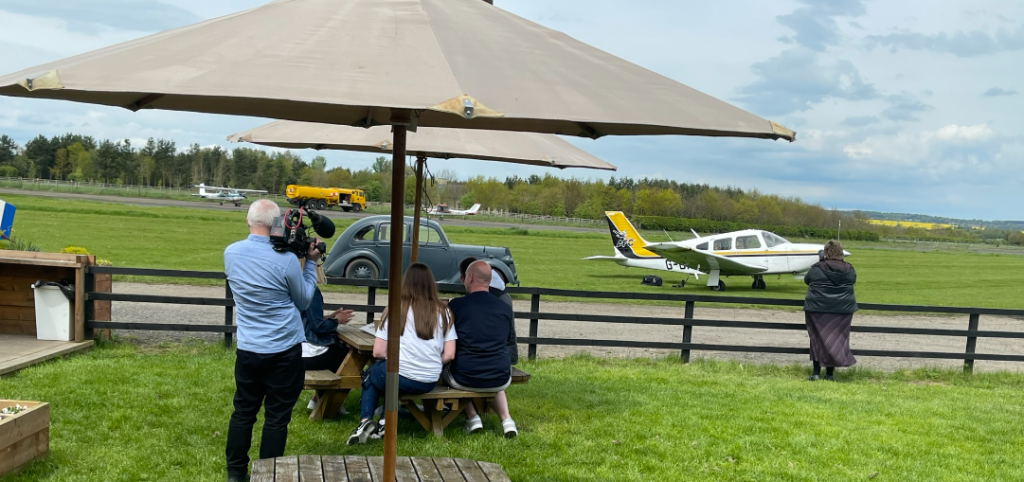
I went and ordered a cappuccino (my usual routine) and when I did so I felt like I was being watched – sure enough there was the lens of that professional camera peering over my shoulder and Jon filmed the making of my cappuccino.
I wonder if it will make the edit?
I at outside and watched the busy aerodrome while I finished my coffee. When I stood to leave I was going to pop over and say hello but Jon was having his lunch so with a polite exchange of nods I left him to it.
Go and follow Jon’s great work at his YouTube and Instagram channels. He’s been a great source of educational and informational videos throughout my journey so far in aviation.
